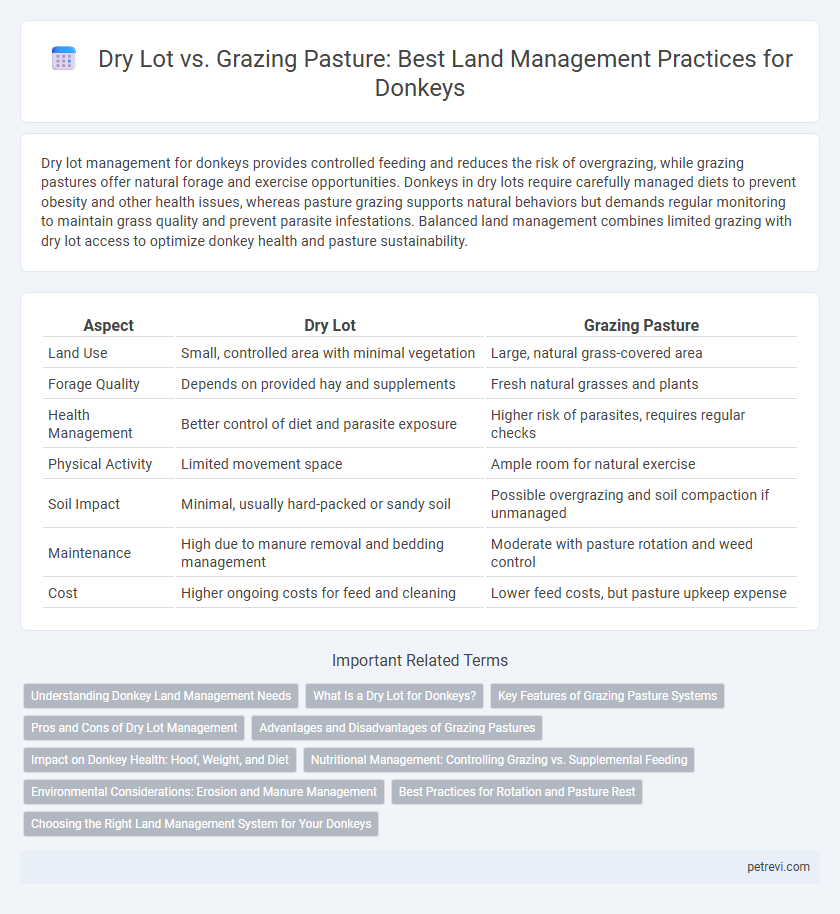Dry lot management for donkeys provides controlled feeding and reduces the risk of overgrazing, while grazing pastures offer natural forage and exercise opportunities. Donkeys in dry lots require carefully managed diets to prevent obesity and other health issues, whereas pasture grazing supports natural behaviors but demands regular monitoring to maintain grass quality and prevent parasite infestations. Balanced land management combines limited grazing with dry lot access to optimize donkey health and pasture sustainability.
Table of Comparison
| Aspect | Dry Lot | Grazing Pasture |
|---|---|---|
| Land Use | Small, controlled area with minimal vegetation | Large, natural grass-covered area |
| Forage Quality | Depends on provided hay and supplements | Fresh natural grasses and plants |
| Health Management | Better control of diet and parasite exposure | Higher risk of parasites, requires regular checks |
| Physical Activity | Limited movement space | Ample room for natural exercise |
| Soil Impact | Minimal, usually hard-packed or sandy soil | Possible overgrazing and soil compaction if unmanaged |
| Maintenance | High due to manure removal and bedding management | Moderate with pasture rotation and weed control |
| Cost | Higher ongoing costs for feed and cleaning | Lower feed costs, but pasture upkeep expense |
Understanding Donkey Land Management Needs
Dry lots provide a controlled environment essential for preventing overgrazing and managing the dietary intake of donkeys, especially those prone to obesity or metabolic issues. Grazing pastures offer natural forage but require careful monitoring to maintain grass quality and prevent nutrient imbalances common in donkeys. Effective donkey land management balances dry lot use with managed grazing to support digestive health, hoof maintenance, and overall well-being.
What Is a Dry Lot for Donkeys?
A dry lot for donkeys is a designated, non-grassy enclosure used to control their grazing and prevent overconsumption of forage. It typically consists of a dirt or sand surface with access to shelter, water, and feed, allowing donkeys to exercise and socialize without risking pasture damage or health issues related to excessive grazing. Utilizing dry lots in donkey land management helps maintain pasture quality and supports the donkeys' digestive health by regulating their diet.
Key Features of Grazing Pasture Systems
Grazing pasture systems for donkeys provide a diverse mix of grasses and legumes that promote natural foraging behavior and improve nutrient intake. These systems support soil health through rotational grazing, which prevents overgrazing and encourages regrowth, enhancing forage quality over time. Properly managed grazing pastures reduce feed costs and offer a more sustainable, low-maintenance land management solution compared to dry lot systems.
Pros and Cons of Dry Lot Management
Dry lot management for donkeys reduces pasture overgrazing and controls diet intake, helping prevent obesity and laminitis. It requires regular cleaning to minimize ammonia buildup and can lead to boredom or stress if donkeys lack adequate enrichment and social interaction. This method offers easier parasite control and soil conservation but demands higher feed costs and consistent water supply maintenance.
Advantages and Disadvantages of Grazing Pastures
Grazing pastures provide donkeys with a natural diet rich in fiber and allow for natural behaviors that promote mental well-being, while supporting soil health through manure distribution. However, grazing pastures carry risks such as parasite exposure, overgrazing, and uneven forage quality, which can lead to nutritional imbalances and hoof problems. Effective pasture management, including rotational grazing and regular parasite control, is essential to maximize benefits and minimize health risks for donkeys.
Impact on Donkey Health: Hoof, Weight, and Diet
Dry lot management helps control donkey weight by limiting excessive grazing, reducing the risk of obesity and related hoof problems such as laminitis. Grazing pasture provides natural forage that supports hoof strength and overall nutrition but requires careful monitoring to prevent overconsumption of rich grasses. Balancing dry lot access with controlled grazing optimizes hoof health, weight management, and a diverse diet, promoting long-term well-being in donkeys.
Nutritional Management: Controlling Grazing vs. Supplemental Feeding
Controlling grazing in dry lots allows precise regulation of forage intake, preventing overconsumption of high-calorie pasture that can lead to obesity in donkeys. Grazing pastures provide natural nutrition and essential fiber but require rotational management to maintain pasture quality and avoid nutrient imbalances. Supplemental feeding in dry lots ensures balanced nutrient intake, addressing deficiencies that grazing alone cannot meet, particularly in periods of poor pasture growth or high energy demands.
Environmental Considerations: Erosion and Manure Management
Dry lots minimize soil erosion by preventing overgrazing and soil compaction commonly seen in grazing pastures, which helps maintain land integrity. Effective manure management in dry lots allows for easier collection and controlled application, reducing nutrient runoff and water contamination risks. Grazing pastures require rotational management to prevent erosion and disperse manure evenly, supporting soil health and reducing environmental impact.
Best Practices for Rotation and Pasture Rest
Dry lot management for donkeys minimizes pasture damage by confining them to a controlled area with supplemental feeding, reducing overgrazing risks. Grazing pasture rotation involves dividing land into multiple paddocks, allowing each section to rest and recover for 21 to 30 days, promoting healthy forage regrowth and soil health. Implementing strategic rest periods based on pasture condition and forage height helps maintain nutritional quality and prevents the buildup of parasites.
Choosing the Right Land Management System for Your Donkeys
Dry lot systems provide controlled feeding environments that reduce parasite exposure and overgrazing, promoting better hoof health and weight management for donkeys. Grazing pastures offer natural foraging opportunities and exercise but require vigilant monitoring to prevent overconsumption of rich grasses, which can lead to obesity and laminitis. Selecting the right land management depends on pasture quality, donkey health status, and the ability to maintain regular land rotation and parasite control protocols.
Dry Lot vs Grazing Pasture for Donkey Land Management Infographic

 petrevi.com
petrevi.com